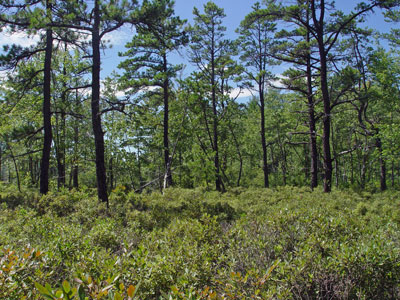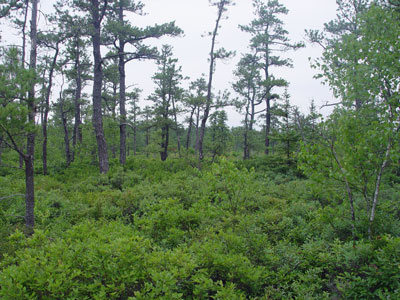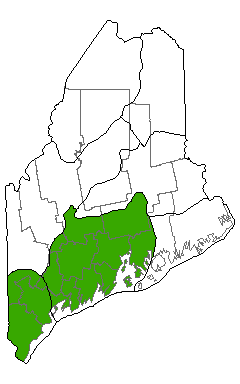DACF Home → Bureaus & Programs → Maine Natural Areas Program → Communities, Plants, and Animals → Natural Community Fact Sheets → Pitch Pine Bog
Printer Friendly Fact Sheet - 1.5 MB pdf (Get a free copy of Adobe Acrobat Reader)
Pitch Pine Bog
Scientific Name: Pitch Pine Bog; State Rank: S2

- Community Description
- Soil and Site Characteristics
- Diagnostics
- Similar Types
- Conservation, Wildlife and Management Considerations
- Distribution
- Characteristic Plants
- Associated Rare Plants
- Associated Rare Animals
- Examples on Conservation Lands You Can Visit
Community Description: Pitch pine is the dominant tree in these sparsely forested peatlands. The shrub layer likewise indicates the more southerly affinities of this type, with maleberry and highbush blueberry common along with the standard bog shrubs of huckleberry and mountain holly. The herb layer may be dense evergreen heath shrubs, especially leatherleaf, or it may be more sparse peat mosses covering the ground. Back to top.
Soil and Site Characteristics: Sites occur in shallow basins on the coastal plain; typical acidic bog conditions predominate. Peat may be shallow, over sandy mineral soil, or deep (>50 cm) as is typical of peatlands. In some cases but not all cases these types are adjacent to pitch pine uplands. Back to top.

Diagnostics: This is an organic soil wetland with abundant peat and low heath shrubs, sparsely forested by pitch pine. Back to top.
Similar Types: Several other peatland community types have very similar dwarf shrub, herb, and bryophyte composition, especially Black Spruce Bogs, Dwarf Shrub Bogs, and Leatherleaf Bogs. The predominance of pitch pine in the tree layer makes this type unique in Maine. Back to top.
Conservation, Wildlife and Management Considerations: Strong development pressures in southern Maine may threaten unprotected sites and degrade their landscape surroundings. Four sites in southern Maine are in public or private conservation ownership.
Birds associated with this community include wetland species such as the common yellowthroat and northern waterthrush. Back to top.
Distribution: Along the north Atlantic coastal plain (Eastern Broadleaf Forest Province) to southern and midcoast Maine. Landscape Pattern: Small Patch, mostly 5-40 acres. Back to top.


Characteristic Plants: These plants are frequently found in this community type. Those with an asterisk are often diagnostic of this community.
- Canopy
- Pitch pine
- Sapling/shrub
- Black chokeberry
- Black huckleberry*
- Highbush blueberry*
- Maleberry
- Mountain holly
- Speckled alder
- Dwarf Shrub
- Large cranberry
- Leatherleaf*
- Sheep laurel
- Herb
- Bracken fern
- Cinnamon fern
- Three-seeded sedge
- Wild sarsaparilla
- Bryoid
- Sphagnum girgensohnii*
There are no documented rare animals associated with this natural community.
Examples on Conservation Lands You Can Visit
| Example | County |
|---|---|
| Brownfield Bog Wildlife Management Area | Oxford Co. |
| East of Little River, Rachel Carson National Wildlife Refuge | York Co. |
| Saco Heath Preserve | York Co. |
| Scarborough Marsh Wildlife Management Area | Cumberland Co. |